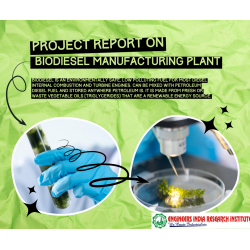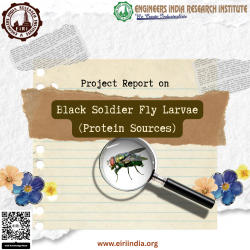Detailed Project Report on biodiesel from algae

- More than 45 years of experience
- Managed by expert industrial consultants
- ISO 9001-2015 Certified
- Registered under MSME, UAM No: DL01E0012000
- 24/5 Research Support
Get your quesries resolved from an industry expert. Ask your queries before report or book purchase. - Custom Research Service
Speak to the our consultant to design an exclusive study to serve your research needs. - Quality Assurance
All reports are prepared by highly qualified consultants & verified by a panel of experts. - Information Security
Your personal & confidential information is safe & secure.
High oil prices, competing demands between foods and other biofuel sources, and the world food crisis, have ignited interest in algaculture (farming algae) for making vegetable oil, biodiesel, bioethanol, biogasoline, biomethanol, biobutanol and other biofuels, using land that is not suitable for agriculture. Among algal fuels' attractive characteristics: they do not affect fresh water resources, can be produced using ocean and wastewater, and are biodegradable and relatively harmless to the environment if spilled. Algae cost more per unit mass (as of 2010, food grade algae costs ~$5000/tonne), due to high capital and operating costs, yet can theoretically yield between 10 and 100 times more energy per unit area than other second-generation biofuel crops. One biofuels company has claimed that algae can produce more oil in an area the size of a two car garage than a football field of soybeans, because almost the entire algal organism can use sunlight to produce lipids, or oil. The Department of Energy estimates that if algae fuel replaced all the petroleum fuel in the country, it would require 15,000 square miles (40,000 km2). This is less than 1⁄7 the area of wheat harvested in 2000.[ However, these claims remain unrealized, commercially. Dry mass factor is the percentage of dry biomass in relation to the fresh biomass; e.g. if the dry mass factor is 5%, one would need 20 kg of wet algae (algae in the media) to get 1 kg of dry algae cells. Lipid content is the percentage of oil in relation to the dry biomass needed to get it, i.e. if the algae lipid content is 40%, one would need 2.5 kg of dry algae to get 1 kg of oil. The vegoil algae product can then be harvested and converted into biodiesel or green-colored crude oil. The algae’s carbohydrate content can be fermented into bioethanol and biobutanol. Currently most research into efficient algal-oil production is being done in the private sector, but predictions from small scale production experiments bear out that using algae to produce biodiesel may be the only viable method by which to produce enough automotive fuel to replace current world diesel usage. Microalgae have much faster growth rates than terrestrial crops. The per unit area yield of oil from algae is estimated to be from between 5,000 to 20,000 US gallons per acre per year (4,700 to 18,000 m3/km2•a). This is 7 to 30 times greater than the next best crop, Chinese tallow (700 US gal/acre•a or 650 m3/km2•a). Studies show that some species of algae can produce up to 60% of their dry weight in the form of oil. Because the cells grow in aqueous suspension, where they have more efficient access to water, CO2 and dissolved nutrients, microalgae are capable of producing large amounts of biomass and usable oil in either high rate algal ponds or photobioreactors. This oil can then be turned into biodiesel which could be sold for use in automobiles. Regional production of microalgae and processing into biofuels will provide economic benefits to rural communities. Butanol can be made from algae or diatoms using only a solar powered biorefinery. This fuel has an energy density 10% less than gasoline, and greater than that of either ethanol or methanol. In most gasoline engines, butanol can be used in place of gasoline with no modifications. In several tests, butanol consumption is similar to that of gasoline, and when blended with gasoline, provides better performance and corrosion resistance than that of ethanol or E85. The green waste left over from the algae oil extraction can be used to produce butanol. Biogasoline is gasoline produced from biomass such as algae. Like traditionally produced gasoline, it contains between 6 (hexane) and 12 (dodecane) carbon atoms per molecule and can be used in internal-combustion engines. Methane a form of natural gas can be produced from algae in various methods, namely Gasification, Pyrolysis and Anaerobic Digestion. In Gasification and Pyrolysis methods methane is extracted under high temperature and pressure. Anaerobic Digestion is a straight forward method involves in decomposition of algae in to simple components then transforming it in to bacteria to release a gas mixture containing methane. The Algenol system which is being commercialized by BioFields in Puerto Libertad, Sonora, Mexico utilizes seawater and industrial exhaust to produce ethanol.
MARKET SURVEY CUM DETAILED TECHNO
ECONOMIC FEASIBILITY REPORT covers
Introduction
Uses and Applications
Properties
Market Survey with future aspects
Present Manufacturers
Detailed Process of Manufacture
Formulations
B.I.S. Specifications
Process Flow Sheet Diagram, Plant Layout,
Cost Economics with Profitability Analysis
Capacity
Land & Building Requirements with Rates
List & Details of Plant and Machinery with their Costs
Raw Materials Details/List and Costs
Power & Water Requirements
Labour/Staff Requirements
Utilities and Overheads
Total Capital Investment
Turnover
Cost of Production
Break Even Point
Profitability
Land Man Ratio
Suppliers of Plant & Machineries and Raw Materials
Cash Flow Statement
Repayment Schedule
Interest Chart
Depreciation Chart
Projected Balance Sheet for 5 Years etc.
How to Make Project Report?
Detailed Project Report (DPR) includes Present Market Position and Expected Future Demand, Technology, Manufacturing Process, Investment Opportunity, Plant Economics and Project Financials. comprehensive analysis from industry covering detailed reporting and evaluates the position of the industry by providing insights to the SWOT analysis of the industry.
Each report include Plant Capacity, requirement of Land & Building, Plant & Machinery, Flow Sheet Diagram, Raw Materials detail with suppliers list, Total Capital Investment along with detailed calculation on Rate of Return, Break-Even Analysis and Profitability Analysis. The report also provides a birds eye view of the global industry with details on projected market size and then progresses to evaluate the industry in detail.
We can prepare detailed project report on any industry as per your requirement.
We can also modify the project capacity and project cost as per your requirement. If you are planning to start a business, contact us today.
Detailed Project Report (DPR) gives you access to decisive data such as:
- Market growth drivers
- Factors limiting market growth
- Current market trends
- Market structure
- Key highlights
Overview of key market forces propelling and restraining market growth:
- Up-to-date analyses of market trends and technological improvements
- Pin-point analyses of market competition dynamics to offer you a competitive edge major competitors
- An array of graphics, BEP analysis of major industry segments
- Detailed analyses of industry trends
- A well-defined technological growth with an impact-analysis
- A clear understanding of the competitive landscape and key product segments
Need Customized Project Report?
- Ask for FREE project related details with our consultant/industry expert.
- Share your specific research requirements for customized project report.
- Request for due diligence and consumer centric studies.
- Still haven't found what you're looking for? Speak to our Custom Research Team
About Engineers India Research Institute:
Note: We can also prepare project report on any subject based on your requirement and country. If you need, we can modify the project capacity and project cost based on your requirement.
Our Clients

Our Approach
- Our research reports comprehensively cover Indian markets (can be modified as per your country), present investigation, standpoint and gauge for a time of five years*.
- The market conjectures are produced on the premise of optional research and are cross-accepted through associations with the business players
- We use dependable wellsprings of data and databases. What's more, data from such sources is handled by us and incorporated into the report
Why buy EIRI reports?
- Our project reports include detailed analysis that help to get industry Present Market Position and Expected Future Demand.
- Offer real analysis driving variables for the business and most recent business sector patterns in the business
- This report comprehends the present status of the business by clarifying a complete SWOT examination and investigation of the interest supply circumstance
- Report gives investigation and top to bottom money related correlation of real players/competitors
- The report gives gauges of key parameters which foresees the business execution


























